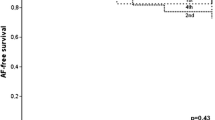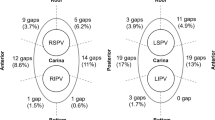Abstract
Aims
Contact force (CF) catheters provide catheter-tissue contact information to improve outcome of pulmonary vein isolation (PVI) in paroxysmal atrial fibrillation (PAF). We evaluated different target-CF values for achievement of the additional endpoint of an unexcitable ablation line.
Methods
A total of 106 patients undergoing PVI were randomized into three groups (G) (G1: target-CF 15 g, G2: target-CF 10 g, G3: CF concealed from operator). The PVI encircling line was divided into predefined sections. Excitable tissue along the PVI-line identified by high output pacing (10 V, 2 ms) was targeted for further ablation.
Results
Mean average CF was 17.4 ± 4.7 g (G1) vs. 12.3 ± 6.0 g (G2) vs. 11.1 ± 6.5 g (G 3) (p < 0.001). Primary unexcitable ablation lines were found in 38.6, 19.4 and 5.7% (G1, G2, G3 respectively; G1 vs. G2 p < 0.05, G1 vs. G3 p < 0.001, G2 vs. G3 ns). Additional radiofrequency (RF)-energy to achieve unexcitability was lowest in G1 (3.6 ± 3.1 kJ vs. 8.6 ± 7.2 kJ (G2) and 10.4 ± 6.7 (G3), p ≤ 0.001, G2 vs. G3 ns) with accordingly lowest additional RF applications in G1 (3.0 ± 2.6 vs. 7.0 ± 5.4 in G2 and 8.4 ± 4.0 in G3; G1 vs. G2 and G3, p < 0.001, G 2 vs. G 3 ns). Sections along ablation lines with low initial CF were most likely to reveal excitability. Single procedure success was 81.9 vs. 73.5 vs. 71.4% (G 1, 2 and 3, p = 0.6) during 437 ± 254 day follow-up.
Conclusion
Higher tip-to-tissue CF during PVI facilitates the achievement of an unexcitable ablation line, requiring less additional RF-energy.





Similar content being viewed by others
References
Willems S, Steven D, Servatius H, Hoffmann BA, Drewitz I, Müllerleile K et al (2010) Persistence of pulmonary vein isolation after robotic remote-navigated ablation for atrial fibrillation and its relation to clinical outcome. J Cardiovasc Electrophysiol 21(10):1079–1084
Rillig A, Lin T, Schmidt B, Feige B, Heeger C, Wegner J et al (2016) Experience matters: long-term results of pulmonary vein isolation using a robotic navigation system for the treatment of paroxysmal atrial fibrillation. Clin Res Cardiol 105(2):106–116
Kettering K, Yim DH, Benz A, Gramley F (2017) Catheter ablation of paroxysmal atrial fibrillation: Circumferential pulmonary vein ablation: Success rates with and without exclusion of areas adjacent to the esophagus. Clin Res Cardiol 106(9):743–51
Wasmer K, Dechering DG, Köbe J, Mönnig G, Pott C, Frommeyer G et al (2016) Pulmonary vein reconnection and arrhythmia progression after antral linear catheter ablation of paroxysmal and persistent atrial fibrillation. Clin Res Cardiol 105(9):738–743
Sohns C, Saguner AM, Lemes C, Santoro F, Mathew S, Heeger C et al (2016) First clinical experience using a novel high-resolution electroanatomical mapping system for left atrial ablation procedures. Clin Res Cardiol 105(12):992–1002
Nakamura K, Naito S, Sasaki T, Minami K, Take Y, Shimizu S et al (2016) Predictors of chronic pulmonary vein reconnections after contact force-guided ablation: Importance of completing electrical isolation with circumferential lines and creating sufficient ablation lesion densities. J Interv Card Electrophysiol 47(3):321–331
Kirchhof P, Benussi S, Kotecha D, Ahlsson A, Atar D, Casadei B et al. 2016 ESC guidelines for the management of atrial fibrillation developed in collaboration with EACTS. Eur Heart J 37(38):2893–2962
Yokoyama K, Nakagawa H, Shah DC, Lambert H, Leo G, Aeby N et al (2008) Novel contact force sensor incorporated in irrigated radiofrequency ablation catheter predicts lesion size and incidence of steam pop and thrombus. Circ Arrhythm Electrophysiol 1(5):354–362
Reddy VY, Shah D, Kautzner J, Schmidt B, Saoudi N, Herrera C et al (2012) The relationship between contact force and clinical outcome during radiofrequency catheter ablation of atrial fibrillation in the TOCCATA study. Heart Rhythm 9(11):1789–1795
Kautzner J, Neuzil P, Lambert H, Peichl P, Petru J, Cihak R et al. EFFICAS II: Optimization of catheter contact force improves outcome of pulmonary vein isolation for paroxysmal atrial fibrillation. Europace, 17(8):1229–1235
Afzal MR, Chatta J, Samanta A, Waheed S, Mahmoudi M, Vukas R et al (2015) Use of contact force sensing technology during radiofrequency ablation reduces recurrence of atrial fibrillation: a systematic review and meta-analysis. Heart Rhythm 12(9):1990–1996
Natale A, Reddy VY, Monir G, Wilber DJ, Lindsay BD, McElderry HT et al (2014) Paroxysmal AF catheter ablation with a contact force sensing catheter: Results of the prospective, multicenter SMART-AF trial. J Am Coll Cardiol 64(7):647–656
Steven D, Reddy VY, Inada K, Roberts-Thomson KC, Seiler J, Stevenson WG, Michaud GF (2010) Loss of pace capture on the ablation line: A new marker for complete radiofrequency lesions to achieve pulmonary vein isolation. Heart Rhythm 7(3):323–330
Steven D, Sultan A, Reddy V, Luker J, Altenburg M, Hoffmann B et al (2013) Benefit of pulmonary vein isolation guided by loss of pace capture on the ablation line: results from a prospective 2-center randomized trial. J Am Coll Cardiol Jul 2;62(1):44–50
Eitel C, Hindricks G, Sommer P, Gaspar T, Kircher S, Wetzel U et al (2010) Circumferential pulmonary vein isolation and linear left atrial ablation as a single-catheter technique to achieve bidirectional conduction block: the pace-and-ablate approach. Heart Rhythm 7(2):157–64
Schaeffer B, Willems S, Sultan A, Hoffmann BA, Lüker J, Schreiber D et al (2015) Loss of pace capture on the ablation line during pulmonary vein isolation versus “dormant conduction”: is adenosine expendable? J Cardiovasc Electrophysiol 26(10):1075–1080
Gunawardene MA, Hoffmann BA, Schaeffer B, Chung D-U, Moser J, Akbulak RO et al. Influence of energy source on early atrial fibrillation recurrences: a comparison of cryoballoon vs. Radiofrequency current energy ablation with the endpoint of unexcitability in pulmonary vein isolation. Europace 2016, 14
Moser J, Sultan A, Lüker J, Servatius H, Salzbrunn T, Altenburg M et al (2017) 5-Year outcome of pulmonary vein isolation by loss of pace capture on the ablation line versus electrical circumferential pulmonary vein isolation. JACC Clin Electrophysiol 3(11). https://doi.org/10.1016/j.jacep.2017.04.019
Kosmidou I, Houde-Walter H, Foley L, Michaud G (2013) Loss of pace capture after radiofrequency application predicts the formation of uniform transmural lesions. Europace 15(4):601–606
Makimoto H, Lin T, Rillig A, Metzner A, Wohlmuth P, Arya A et al (2014) In vivo contact force analysis and correlation with tissue impedance during left atrial mapping and catheter ablation of atrial fibrillation. Circ Arrhythm Electrophysiol 7(1):46–54
Ullah W, McLean A, Tayebjee MH, Gupta D, Ginks MR, Haywood GA et al (2016) Randomized trial comparing pulmonary vein isolation using the smarttouch catheter with or without real-time contact force data. Heart Rhythm 13(9):1761–1767
Park CI, Lehrmann H, Keyl C, Weber R, Schiebeling J, Allgeier J et al (2014) Mechanisms of pulmonary vein reconnection after radiofrequency ablation of atrial fibrillation: The deterministic role of contact force and interlesion distance. J Cardiovasc Electrophysiol 25(7):701–708
Okumura Y, Watanabe I, Iso K, Nagashima K, Sonoda K, Sasaki N et al (2016) Clinical utility of automated ablation lesion tagging based on catheter stability information (visitag module of the CARTO 3 system) with contact force-time integral during pulmonary vein isolation for atrial fibrillation. J Interv Card Electrophysiol 47(2):245–252
Rozen G, Ptaszek L, Zilberman I, Cordaro K, Heist EK, Beeckler C et al (2017) Prediction of radiofrequency ablation lesion formation using a novel temperature sensing technology incorporated in a force sensing catheter. Heart Rhythm 14(2):248–254
Das M, Loveday JJ, Wynn GJ, Gomes S, Saeed Y, Bonnett LJ et al (2017) Ablation index, a novel marker of ablation lesion quality: prediction of pulmonary vein reconnection at repeat electrophysiology study and regional differences in target values. Europace 19(5):775–783
Gitenay E, O’ Hara GE, Sarrazin J-F, Nault I, Philippon F, Sadron Blaye-Felice M et al (2016) Contact-force catheters: efficacy versus safety? Case report of 2 atrioesophageal fistulae. J Cardiovasc Electrophysiol 27(12):1483–1487
Shurrab M, Di Biase L, Briceno DF, Kaoutskaia A, Haj-Yahia S, Newman D et al (2015) Impact of contact force technology on atrial fibrillation ablation: a meta-analysis. J Am Heart Assoc 4(9):e002476
Author information
Authors and Affiliations
Corresponding author
Ethics declarations
Conflict of interest
On behalf of all authors, the corresponding author states that there is no conflict of interest.
Rights and permissions
About this article
Cite this article
Schaeffer, B., Willems, S., Meyer, C. et al. Contact force facilitates the achievement of an unexcitable ablation line during pulmonary vein isolation. Clin Res Cardiol 107, 632–641 (2018). https://doi.org/10.1007/s00392-018-1228-0
Received:
Accepted:
Published:
Issue Date:
DOI: https://doi.org/10.1007/s00392-018-1228-0




